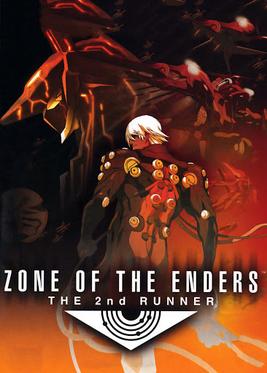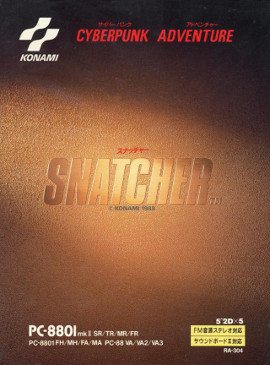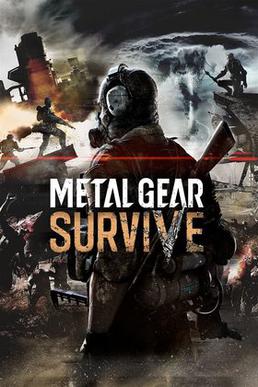
Metal Gear Solid is an action-adventure stealth video game developed and published by Konami for the PlayStation in 1998. It was directed, produced, and written by Hideo Kojima, and follows the MSX2 video games Metal Gear and Metal Gear 2: Solid Snake, which Kojima also worked on. It was unveiled at the 1996 Tokyo Game Show and then demonstrated at trade shows including the 1997 Electronic Entertainment Expo; its Japanese release was originally planned for late 1997, before being delayed to 1998.
Metal Gear is a franchise of stealth games created by Hideo Kojima. Developed and published by Konami, the first game, Metal Gear, was released in 1987 for MSX home computers. The player often takes control of a special forces operative, who is assigned the task of finding the titular superweapon, "Metal Gear", a bipedal walking tank with the ability to launch nuclear weapons.
Silent Hill is a horror anthology media franchise centered on a series of survival horror games created by Keiichiro Toyama and published by Konami. The first four video games in the series, Silent Hill, Silent Hill 2, Silent Hill 3, and Silent Hill 4: The Room, were developed by an internal group called Team Silent, a development staff within former Konami subsidiary Konami Computer Entertainment Tokyo.

Metal Gear Solid 3: Snake Eater is a 2004 action-adventure stealth video game developed and published by Konami for the PlayStation 2. It was released in late 2004 in North America and Japan, and in early 2005 in Europe and Australia. It was the fifth Metal Gear game written and directed by Hideo Kojima and serves as a prequel to the entire Metal Gear series. An expanded edition, titled Metal Gear Solid 3: Subsistence, was released in Japan in late 2005, then in North America, Europe and Australia in 2006. A remastered version of the game, Metal Gear Solid 3: Snake Eater - HD Edition, was later included in the Metal Gear Solid HD Collection for the PlayStation 3, Xbox 360, and PlayStation Vita, while a reworked version, titled Metal Gear Solid: Snake Eater 3D, was released for the Nintendo 3DS in 2012. The HD Edition of the game was included on the Metal Gear Solid: Master Collection Vol. 1 compilation for Nintendo Switch, PlayStation 4, PlayStation 5, Windows, and Xbox Series X/S on October 24, 2023. The same year, Konami announced a remake, entitled Metal Gear Solid Delta: Snake Eater, set to release for PlayStation 5, Windows, and Xbox Series X/S in 2024.

Yoji Shinkawa is a Japanese artist. He is best known as the lead character and mecha designer for the Metal Gear franchise. He has collaborated with Hideo Kojima on many of his games.

Policenauts is a graphic adventure game developed and published by Konami. It was written and directed by Hideo Kojima, and originally released for the PC-9821 in 1994. A hard science fiction story, Policenauts is set in the mid 21st century and follows Jonathan Ingram, an astronaut recently recovered floating in space in cryosleep after an accident at a space colony sent him drifting into space for 24 years. Now a detective in Los Angeles, Ingram travels back to the colony to investigate the murder of his ex-wife and her husband's disappearance. As he begins his investigation, he starts to uncover an illegal organ trafficking ring.

Zone of the Enders, officially abbreviated as Z.O.E., is a 2001 third-person shooter hack-and-slash video game that was developed and published by Konami for the Sony PlayStation 2. The game is based around mecha combat in outer space. Over the course of the game, the player obtains new weapons and has to protect towns from enemies.
Zone of the Enders: 2167 Idolo is an hour-long Original Video Animation, set as a prequel to the original Zone of the Enders game. It serves to explain the war between Earth and Mars, and the origin of the Orbital Frame technology. The events also lead into the TV series Z.O.E. Dolores, I.

Zone of the Enders: The 2nd Runner, known in Japan as Anubis: Zone of the Enders, is a third-person shooter hack and slash video game that was developed and published by Konami for the PlayStation 2 in 2003. The sequel to Zone of the Enders is based around mecha combat with the player once again controlling the "Orbital Frame" Jehuty. Unlike its predecessor, the game is now centered on action elements with the player not needing to protect civilians in need and instead Jehuty contains more weaponry than in the previous game.

Metal Gear Solid 4: Guns of the Patriots is a 2008 action-adventure stealth video game developed by Kojima Productions and published by Konami for the PlayStation 3. It is the sixth Metal Gear game directed by Hideo Kojima. Set five years after the events of Metal Gear Solid 2: Sons of Liberty, the story centers around a prematurely aged Solid Snake, now known as Old Snake, as he goes on one last mission to assassinate his nemesis Liquid Snake, who now inhabits the body of his former henchman Revolver Ocelot under the guise of Liquid Ocelot, before he takes control of the Sons of the Patriots, an A.I. system that controls the activities of PMCs worldwide. The game was released on June 12, 2008.

Zone of the Enders: The Fist of Mars, known in Japan as Zone of the Enders: 2173 Testament, is a video game that was developed by Winkysoft and published by Konami in 2001 for the Game Boy Advance. The game is story-orientated, and is based around turn-based strategic mecha combat.

Silent Hill 3 is a 2003 survival horror game developed by Team Silent, a group in Konami Computer Entertainment Tokyo, and published by Konami. The game was released from May to August, originally for the PlayStation 2. The third installment in the Silent Hill series and a direct sequel to the first Silent Hill game, it follows Heather, a teenager who becomes entangled in the machinations of the town's cult, which seeks to revive a malevolent deity. A port for Microsoft Windows was released later in November, and a remastered high-definition version was released as part of the Silent Hill HD Collection, for the PlayStation 3 and Xbox 360 in 2012.

Metal Gear Rising: Revengeance is a 2013 action-adventure game developed by PlatinumGames and published by Konami. It was released for the PlayStation 3 and Xbox 360 in February 2013, Windows and OS X in January and September 2014, and Nvidia Shield TV in January 2016.

Metal Gear Solid: Peace Walker is a 2010 stealth game developed by Kojima Productions and published by Konami. It is the seventh Metal Gear game written, directed, and designed by Hideo Kojima, and the fifth installment of the Metal Gear Solid series, as well as the fourth Metal Gear game made specifically for the PlayStation Portable, following Metal Gear Solid: Portable Ops. A remastered version of the game titled Metal Gear Solid: Peace Walker - HD Edition was later released for the PlayStation 3 and Xbox 360 as part of the Metal Gear Solid HD Collection in North America and Europe and as a stand-alone retail release in Japan.

Metal Gear Solid HD Collection is a compilation of remastered ports of Metal Gear video games released for PlayStation 3 and Xbox 360 in 2011 and PlayStation Vita in 2012. The compilation contains Metal Gear Solid 2: Sons of Liberty and Metal Gear Solid 3: Snake Eater on all three platforms, plus Metal Gear Solid: Peace Walker on the home console versions, with the individual games all branded as HD Edition. Bluepoint Games handled the conversions of Metal Gear Solid 2 and 3, while Genki worked on Peace Walker.

Silent Hill HD Collection is a 2012 video game compilation of remastered video game ports of Silent Hill 2 (2001) and Silent Hill 3 (2003) developed by Hijinx Studios for the PlayStation 3 and Xbox 360 consoles. Silent Hill 2 centers on widower James Sunderland who travels to the titular town after receiving a letter from his dead wife, while Silent Hill 3 is a direct sequel to the first Silent Hill game and focuses on Heather Mason, a teenager who finds herself in conflict with the town's cult. Both games are categorized as survival horror and share gameplay elements with each other. Published worldwide by Konami beginning with North America in March 2012, the compilation features a graphics overhaul, new voice acting, and Xbox achievements and PlayStation trophies.

The Fox Engine was a proprietary game engine by Konami. The engine's development began with Hideo Kojima after the completion of 2008's Metal Gear Solid 4, with the goal of making the "best engine in the world." The first commercially released title to use the Fox Engine was Pro Evolution Soccer 2014.

Metal Gear Solid V: Ground Zeroes is a 2014 action-adventure stealth video game developed by Kojima Productions and published by Konami. It is the eighth game in the Metal Gear series directed, written and designed by Hideo Kojima, and serves as a prologue to Metal Gear Solid V: The Phantom Pain, released the following year. Set in 1975, a few months after the events of Metal Gear Solid: Peace Walker, the story follows Snake as he infiltrates an American black site in Cuba called Camp Omega, attempting to rescue Cipher agent Paz Ortega Andrade and former Sandinista child soldier Ricardo "Chico" Valenciano Libre.

Snatcher is a cyberpunk graphic adventure game developed and published by Konami. It was written and designed by Hideo Kojima and first released in 1988 for the PC-8801 and MSX2 in Japan. Snatcher is set in a future East Asian metropolis where humanoid robots dubbed "Snatchers" have been discovered killing humans and replacing them in society. The game follows Gillian Seed, an amnesiac who joins an anti-Snatcher agency in search of his past. Gameplay takes place primarily through a menu-based interface through which the player can choose to examine items, search rooms, speak to characters, explore a semi-open world, and perform other actions.

Metal Gear Survive is a 2018 survival game developed by Konami Digital Entertainment and published by Konami. The game was released for PlayStation 4, Windows, and Xbox One in February 2018. It is the first Metal Gear game to be developed following the series' creator Hideo Kojima's departure from Konami in late 2015, and the first since 1990's Snake's Revenge to be made without Kojima's input. Survive takes place between the events of Metal Gear Solid V: Ground Zeroes and Metal Gear Solid V: The Phantom Pain, and follows the Captain, an MSF soldier who enters a parallel dimension and establishes a local command center to unravel the mysteries of a strange virus that turns people into zombie-like creatures.

















